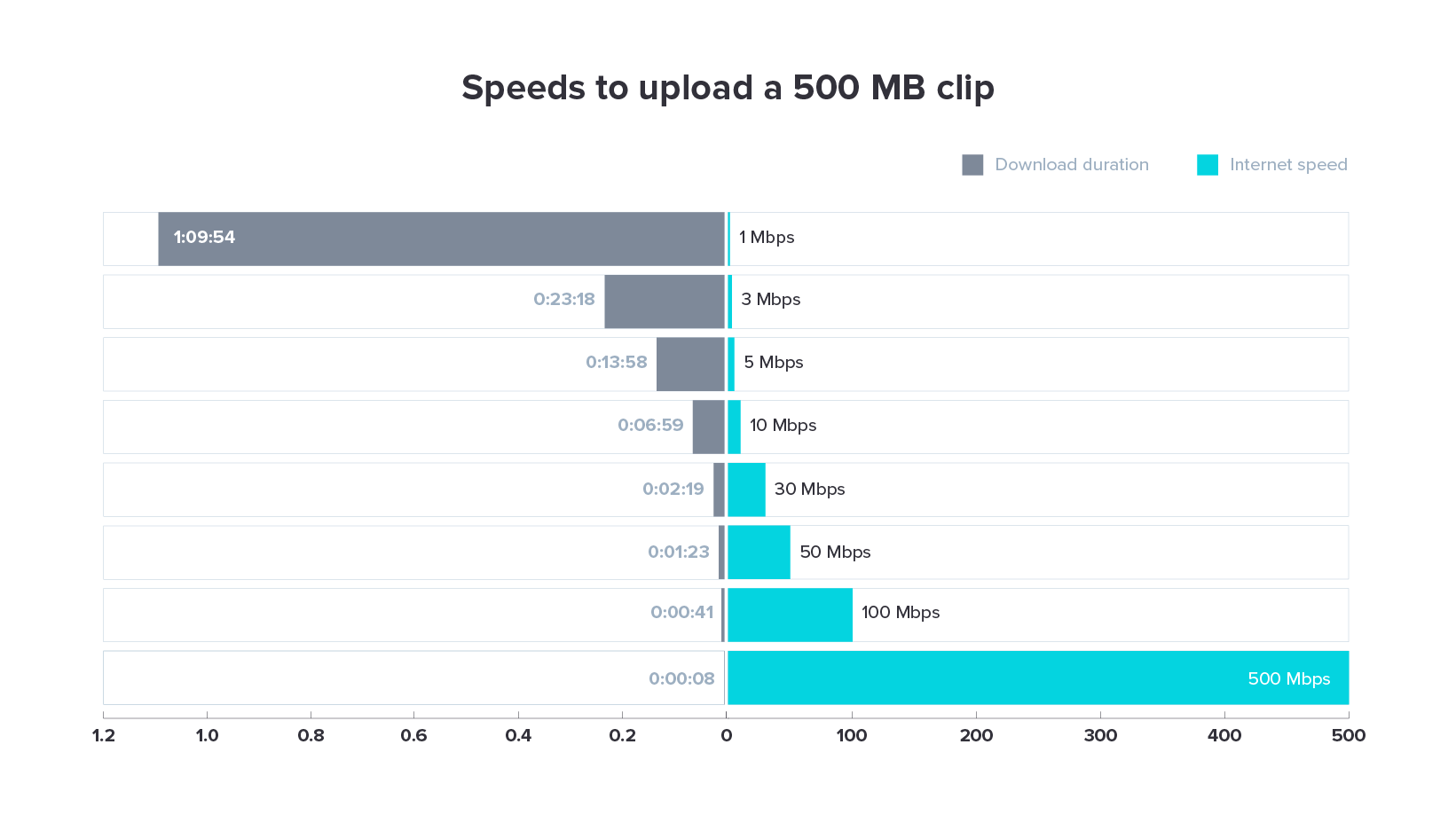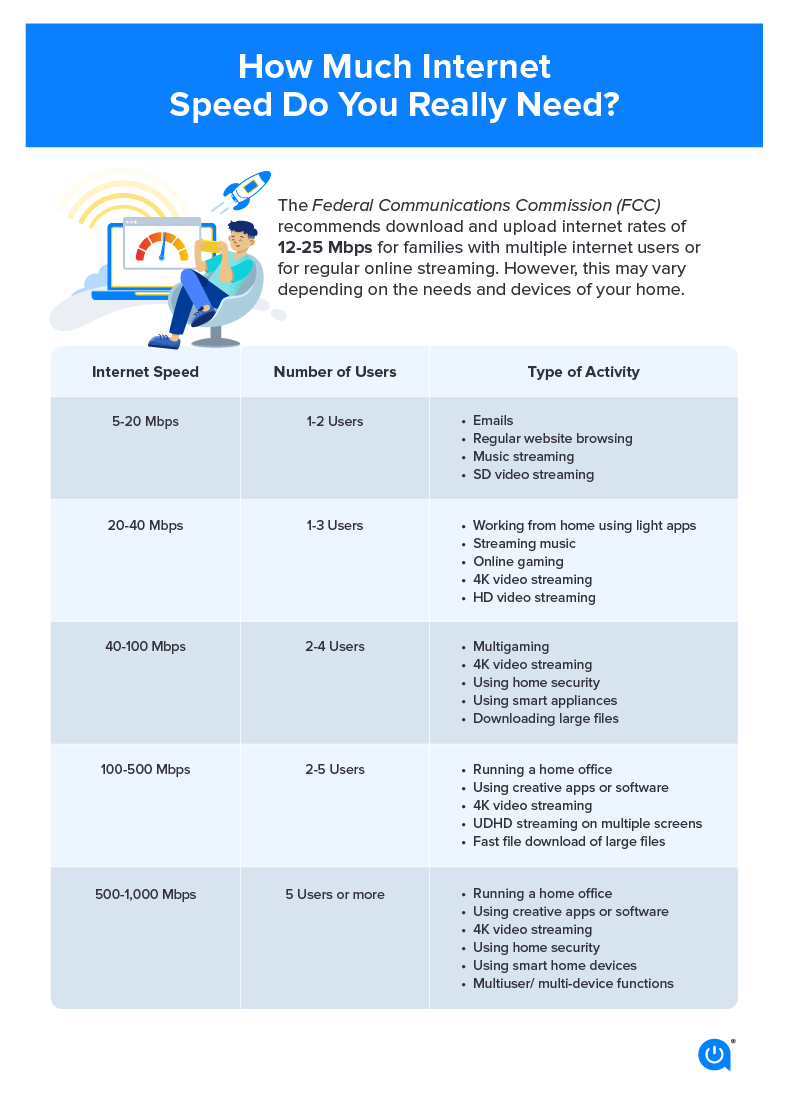The Influence of Megabits Per Second on Streaming Quality and Performance
The Influence of Megabits Per Second on Streaming Quality and Performance
Blog Article
Just How Megabits Per Second Influence Your Online Tasks
The principle of megabits per second (Mbps) plays a crucial role fit our online experiences. As digital activities proliferate, understanding the ramifications of Mbps on streaming, video gaming, and video clip conferencing comes to be significantly vital. Greater Mbps can improve performance and decrease interruptions, while insufficient speeds may foster disappointment and ineffectiveness. Evaluating your home's particular requirements in regard to these speeds is essential, particularly as numerous gadgets try transmission capacity. Yet, the subtleties of how Mbps affects numerous online tasks require additional expedition, specifically as our dependence on electronic connectivity remains to evolve.
Recognizing Megabits Per Second
When taking into consideration internet rate, it's important to understand the principle of megabits per second (Mbps), which functions as a basic dimension for data transfer prices. This statistics measures just how much information can be transmitted over a web link in one second, supplying a clear understanding of performance capacities - Megabits Per Second. For context, one megabit amounts to one million little bits, and Mbps is commonly utilized to share bandwidth for different online tasks
A greater Mbps indicates a quicker internet link, enabling users to execute tasks such as downloading and install documents, browsing sites, and involving in on-line gaming a lot more efficiently. As an example, normal surfing requires around 1-5 Mbps, while streaming high-definition video may require 5-25 Mbps. Understanding these demands is vital for determining the suitable web speed needed for certain activities.
Additionally, the number of devices connected to a network can influence general performance. Multiple users streaming, video gaming, or downloading and install simultaneously can strain available data transfer, resulting in slower speeds - Megabits Per Second. Evaluating personal online practices and demands is crucial in choosing a web strategy that aligns with one's needs, ensuring a smooth electronic experience
Streaming and Buffering Issues
Streaming high-def material has become a staple of modern online home entertainment, yet it is commonly gone along with by annoying buffering issues. These interruptions can significantly interfere with the seeing experience, bring about frustration and prospective loss of audience involvement. Buffering takes place when the data transmitted from the streaming solution is not obtained swiftly enough to keep a smooth playback, usually because of insufficient net rate determined in megabits per second (Mbps)

Moreover, real-time streaming can be influenced by network blockage, which occurs when multiple tools share the very same data transfer. As a result, optimizing link rate and making certain ample Mbps is important for a seamless streaming experience. As streaming solutions remain to progress, comprehending the influence of Mbps on buffering problems remains crucial for consumers looking for continuous home entertainment.
Online Gaming Efficiency
The impact of net rate on online tasks extends past streaming, considerably affecting on the internet gaming performance. In competitive pc gaming, reduced latency and high transmission capacity are important for a smooth experience. A fast link decreases lag, allowing players to react swiftly to in-game occasions, which can be the distinction between success and defeat.
Data transfer, gauged in megabits per second (Mbps), plays a crucial function in supporting several you could check here gadgets and pc gaming platforms all at once. Inadequate transmission capacity can lead to went down connections or reduced video why not try these out game quality, adversely impacting gameplay. For circumstances, on the internet multiplayer games require substantial data transfer, specifically during peak gaming hours when various gamers are online.
Additionally, the kind of video game can also dictate the needed net rate. Busy first-person shooters require greater speeds to preserve responsiveness, while turn-based method video games might work fairly well on reduced rates. As online gaming remains to evolve, with enhancing graphical fidelity and more complicated multiplayer environments, the demand for greater Mbps will just intensify. Gamers should guarantee they have adequate net rate to improve their pc gaming performance and overall experience. Buying a durable internet link is necessary for gamers aiming to enhance their performance and pleasure.
Video Clip Conferencing Quality
In today's electronic landscape, video conferencing quality is heavily influenced by web rate, particularly in terms of data transfer and latency. Premium video calls require enough transmission capacity to transfer sound and video clip information effortlessly. Normally, a minimum of 1.5 Mbps upload and download rates is suggested for basic definition video, while high-definition video conferencing typically demands at least 3 Mbps.
Latency, or the delay in between sending out and receiving data, also plays a vital role in the customer experience. Low latency makes sure that conversations circulation naturally without uncomfortable stops or interruptions. Ideally, latency should be below 150 nanoseconds for reliable interaction. Greater latency can result in echo, lag, and disjointed communications, which can prevent partnership and engagement during meetings.
Additionally, multiple participants in a video conference can stress offered bandwidth, necessitating also greater rates. Network blockage, often triggered by simultaneous tasks like streaming or downloading, can even more weaken video clip top quality. Hence, for companies counting on video clip conferencing for remote cooperation, understanding the relationship between megabits per total and second communication quality is crucial for preserving performance and enhancing virtual interactions.
Picking the Right Internet Plan
Selecting a suitable web plan is important for ensuring optimum performance in different online activities, specifically in setups that demand high transmission capacity, such as video clip conferencing and online video gaming. Megabits Per Second. When considering a net strategy, it is vital to review both the rate and information allocation to match your certain usage demands
For households useful site with multiple individuals taking part in simultaneous activities, a strategy providing higher megabits per second (Mbps) is suggested. Normally, a minimum of 25 Mbps appropriates for basic streaming and browsing, while plans surpassing 100 Mbps are more suitable for even more extensive jobs. Additionally, think about the nature of your online tasks; video clip conferencing requires a minimum of 1.5 Mbps post speed, while on-line pc gaming may need a lower latency yet constant link.
It is likewise essential to examine your information cap. Endless information strategies can avoid throttling and interruptions, especially if hefty usage is expected. Study service suppliers in your location, as accessibility and rates can vary. By attentively choosing an internet plan customized to your requirements, you can improve your on-line experience, guaranteeing smooth, nonstop access to your preferred tasks.
Conclusion
To conclude, the importance of megabits per second (Mbps) in shaping on-line activities can not be overstated. Higher Mbps helps with seamless streaming, lowers buffering, enhances gaming experiences, and ensures premium video conferencing. On the other hand, insufficient data transfer can result in frustrating interruptions and diminished performance throughout numerous jobs. A complete understanding of private or home Mbps requirements is crucial for picking a proper net plan that adequately supports varied online activities and individual demands.

Typically, a minimum of 25 Mbps is suitable for standard streaming and browsing, while plans exceeding 100 Mbps are more suitable for more extensive tasks. Additionally, consider the nature of your online tasks; video conferencing needs at least 1.5 Mbps upload rate, while on the internet gaming might need a lower latency yet regular link.
Report this page